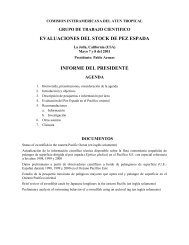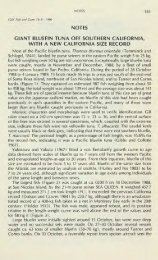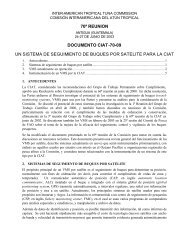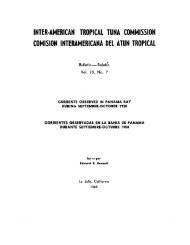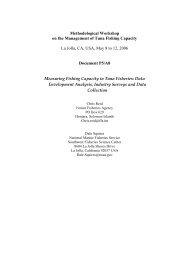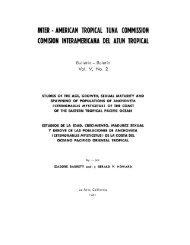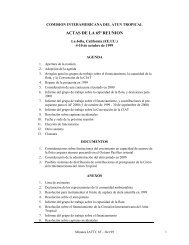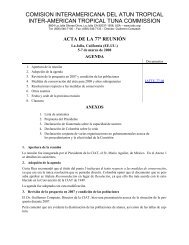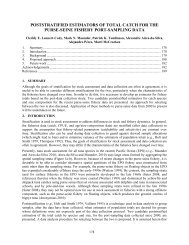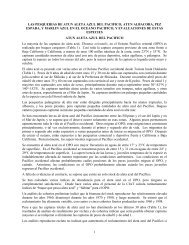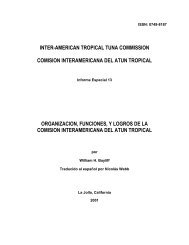INTER-AMERICAN TROPICAL TUNA COMMISSION - Comisión ...
INTER-AMERICAN TROPICAL TUNA COMMISSION - Comisión ...
INTER-AMERICAN TROPICAL TUNA COMMISSION - Comisión ...
- No tags were found...
You also want an ePaper? Increase the reach of your titles
YUMPU automatically turns print PDFs into web optimized ePapers that Google loves.
116Some marine mammals are adversely affected by reduced food availability during El Niño events, especially in coastal ecosystems.Examples that have been documented include dolphins, pinnipeds, and Bryde’s whales off Peru, and pinnipeds around the GalapagosIslands. Large whales are able to move in response to changes in prey productivity and distribution.2.6. Sea turtlesSea turtles are caught on longlines when they take the bait on hooks, are snagged accidentally by hooks, or are entangled in the lines.Estimates of incidental mortality of turtles due to longline and gillnet fishing are few. At the 4th meeting of the IATTC WorkingGroup on Bycatch in January 2004, it was reported that 166 leatherback (Dermochelys coriacea) and 6,000 other turtle species,mostly olive Ridley (Lepidochelys olivacea), were incidentally caught by Japan’s longline fishery in the EPO during 2000, and that,of these, 25 and 3,000, respectively, were dead. At the 6th meeting of the Working Group in February 2007, it was reported that theSpanish longline fleet targeting swordfish in the EPO averaged 65 interactions and 8 mortalities per million hooks during 1990-2005. The mortality rates due to longlining in the EPO are likely to be similar for other fleets targeting bigeye tuna, and possiblygreater for those that set their lines at shallower depths for albacore and swordfish. About 23 million of the 200 million hooks seteach year in the EPO by distant-water longline vessels target swordfish with shallow longlines.In addition, there is a sizeable fleet of artisanal longline vessels that fish for tunas, billfishes, sharks, and dorado (Coryphaena spp.)in the EPO. Since 2005, staff members of the IATTC and some other organizations, together with the governments of several coastalLatin American nations, have been engaged in a program to reduce the hooking rates and mortalities of sea turtles in these fisheries.Additional information on this program can be found in Section 8.2.Sea turtles are occasionally caught in purse seines in the EPO tuna fishery. Most interactions occur when the turtles associate withfloating objects, and are captured when the object is encircled. In other cases, nets set around unassociated schools of tunas orschools associated with dolphins may capture sea turtles that happen to be at those locations. The olive Ridley turtle is, by far, thespecies of sea turtle taken most often by purse seiners. It is followed by green sea turtles (Chelonia mydas), and, very occasionally,by loggerhead (Caretta caretta) and hawksbill (Eretmochelys imbricata) turtles. Only one mortality of a leatherback turtle has beenrecorded during the 10 years that IATTC observers have been recording this information. Some of the turtles are unidentified becausethey were too far from the vessel or it was too dark for the observer to identify them. Sea turtles, at times, become entangled inthe webbing under fish-aggregating devices (FADs) and drown. In some cases, they are entangled by the fishing gear and may beinjured or killed. Preliminary estimates of the mortalities (in numbers) of turtles caused by large purse-seine vessels during 2008 areas follows:Set typeOBJ NOA DELTotalOlive Ridley 1 0 0 1Eastern Pacific green 0 0 0 0Loggerhead 0 0 0 0Hawksbill 0 0 0 0Leatherback 0 0 0 0Unidentified 1 0 0 1Total 2 0 0 2The mortalities of sea turtles due to purse seining for tunas are probably less than those due to other types of human activity, whichinclude exploitation of eggs and adults, beach development, pollution, entanglement in and ingestion of marine debris, and impactsof other fisheries.The populations of olive Ridley, green, and loggerhead turtles are designated as endangered, and those of hawksbill and leatherbackturtles as critically endangered, by the International Union for the Conservation of Nature.2.7. Sharks and other large fishesSharks and other large fishes are taken by both purse-seine and longline vessels. Silky sharks (Carcharhinus falciformis) are themost commonly-caught species of shark in the purse-seine fishery, followed by oceanic whitetip sharks (C. longimanus). Thelongline fisheries also take significant quantities of silky sharks, and a Pacific-wide analysis of longline and purse-seine fishing isnecessary to estimate the impact of fishing on the stock(s). Preliminary estimates of indices of relative abundance of silky sharks,based on data for purse-seine sets on floating objects, show a decreasing trend during 1994-2006; the trends in unstandardized by-



